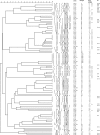Antibiotic-resistant invasive pneumococcal clones in Italy
- PMID: 17122014
- PMCID: PMC1829026
- DOI: 10.1128/JCM.01229-06
Antibiotic-resistant invasive pneumococcal clones in Italy
Erratum in
- J Clin Microbiol. 2007 Sep;45(9):3148
Abstract
A total of 105 multiple-antibiotic-resistant invasive pneumococcal isolates recovered in Italy from 2001 to 2003 were genetically characterized. Of these, 40 were penicillin-nonsusceptible (PNSSP) and 65 were penicillin-susceptible (PSSP) Streptococcus pneumoniae strains. Among the PNSSP isolates, 8 and 11 different restriction profiles were obtained for the pbp2b and pbp2x genes, respectively. Clonal groups were established on the basis of analysis of both pulsed-field gel electrophoresis (PFGE) types and multilocus sequence typing (MLST). Several international clones, such as Spain(23F)-1/ST81, Spain(6B)-2/ST90, Spain(9V)-3/ST156, and Sweden(15A)-25/ST63 [corrected] were identified among the PNSSP isolates. Other, smaller clones, such as the minor Spanish 19F clone/ST88 and Denmark(14)-32/ST230, were also found. Among the PSSP isolates, clones related to England(14)-9/ST9, Greece(6B)-22/ST273, and Portugal(19F)-21/ST177 were found. In addition, two large clones comprised nonvaccine serotypes. One, comprising serotype 3 isolates, corresponded to the clone Netherlands(3)-31/ST180; the other, comprising serotype 15B/C isolates, ST474, was not related to any previously described clone. Two small clusters related to the newly described clones Greece(21)-30/ST193 and Netherlands(15B)-37/ST199 included isolates with unrelated PFGE profiles. An unusual finding was the inability to obtain the MLST allelic profile for an isolate of serotype 19A, belonging to the Sweden(15A)-25/ST63 [corrected] clone, due to a large deletion of the xpt gene. Capsular switching was observed among both PNSSP and PSSP isolates and involved also serotypes not included in the 7-valent pneumococcal conjugate vaccine (PCV7), such as serotypes 15B/C and 19A. Since antibiotic-resistant nonvaccine serotype clones are present in Italy, continuous monitoring of pneumococcal epidemiology should be carried out in the PCV7 era.
Figures

Similar articles
-
High Rate of Serotype Switching and Genetic Variations Indicates Widespread Recombination Between Clinical and Commensal Penicillin-Nonsusceptible Streptococcus pneumoniae in Tehran.Microb Drug Resist. 2019 Jul/Aug;25(6):865-873. doi: 10.1089/mdr.2018.0336. Epub 2019 Feb 20. Microb Drug Resist. 2019. PMID: 30785836
-
Phenotypic and genotypic characterization of two penicillin-susceptible serotype 6B Streptococcus pneumoniae clones circulating in Italy.J Clin Microbiol. 2003 Jul;41(7):2855-61. doi: 10.1128/JCM.41.7.2855-2861.2003. J Clin Microbiol. 2003. PMID: 12843012 Free PMC article.
-
Emergence of penicillin-nonsusceptible Streptococcus pneumoniae clones expressing serotypes not present in the antipneumococcal conjugate vaccine.J Infect Dis. 2004 Dec 15;190(12):2154-61. doi: 10.1086/425908. Epub 2004 Nov 11. J Infect Dis. 2004. PMID: 15551214
-
Macrolide resistance in Streptococcus pneumoniae: clonality and mechanisms of resistance in 24 countries.Curr Drug Targets Infect Disord. 2004 Sep;4(3):169-76. doi: 10.2174/1568005043340821. Curr Drug Targets Infect Disord. 2004. PMID: 15379728 Review.
-
Molecular typing of the pneumococcus and its application in epidemiology in sub-Saharan Africa.Front Cell Infect Microbiol. 2013 Mar 14;3:12. doi: 10.3389/fcimb.2013.00012. eCollection 2013. Front Cell Infect Microbiol. 2013. PMID: 23503978 Free PMC article. Review.
Cited by
-
Increasing incidence of Streptococcus pneumoniae serotype 19A and emergence of two vaccine escape recombinant ST695 strains in Liguria, Italy, 7 years after implementation of the 7-valent conjugated vaccine.Clin Vaccine Immunol. 2011 Feb;18(2):343-5. doi: 10.1128/CVI.00383-10. Epub 2010 Dec 22. Clin Vaccine Immunol. 2011. PMID: 21177921 Free PMC article.
-
Emergence of Multidrug-Resistant Pneumococcal Serotype 35B among Children in the United States.J Clin Microbiol. 2017 Mar;55(3):724-734. doi: 10.1128/JCM.01778-16. Epub 2016 Nov 9. J Clin Microbiol. 2017. PMID: 27847379 Free PMC article.
-
Differentially expressed outer membrane proteins of Vibrio alginolyticus in response to six types of antibiotics.Mar Biotechnol (NY). 2010 Nov;12(6):686-95. doi: 10.1007/s10126-009-9256-4. Epub 2010 Mar 9. Mar Biotechnol (NY). 2010. PMID: 20217167
-
Molecular typing methods for outbreak detection and surveillance of invasive disease caused by Neisseria meningitidis, Haemophilus influenzae and Streptococcus pneumoniae, a review.Microbiology (Reading). 2011 Aug;157(Pt 8):2181-2195. doi: 10.1099/mic.0.050518-0. Epub 2011 May 26. Microbiology (Reading). 2011. PMID: 21622526 Free PMC article. Review.
-
Serotype and clonal evolution of penicillin-nonsusceptible invasive Streptococcus pneumoniae in the 7-valent pneumococcal conjugate vaccine era in Italy.Antimicrob Agents Chemother. 2012 Sep;56(9):4965-8. doi: 10.1128/AAC.00830-12. Epub 2012 Jul 2. Antimicrob Agents Chemother. 2012. PMID: 22751537 Free PMC article.
References
-
- Boccia, D., S. Spila Alegiani, A. Pantosti, M. L. Moro, and G. Traversa. 2004. The geographic relationship between the use of antimicrobial drugs and the pattern of resistance for Streptococcus pneumoniae in Italy. Eur. J. Pharmacol. 60:115-119. - PubMed
-
- Brueggemann, A., D. Griffiths, E. Meats, T. Peto, D. Crook, and B. Spratt. 2003. Clonal relationships between invasive and carriage Streptococcus pneumoniae and serotype- and clone-specific differences in invasive disease potential. J. Infect. Dis. 187:1424-1432. - PubMed
-
- Camilli, R., E. Pettini, M. Del Grosso, G. Pozzi, A. Pantosti, and M. Oggioni. 2006. Zinc metalloproteinase genes in clinical isolates of Streptococcus pneumoniae: association of the full array with a clonal cluster comprising serotypes 8 and 11A. Microbiology 152:313-321. - PubMed
-
- Clinical and Laboratory Standards Institute. 2006. Performance standards for antimicrobial susceptibility testing; 16th informational supplement. M100-S16. Clinical and Laboratory Standards Institute, Wayne, PA.
MeSH terms
Substances
Associated data
- Actions
LinkOut - more resources
Full Text Sources
Medical

